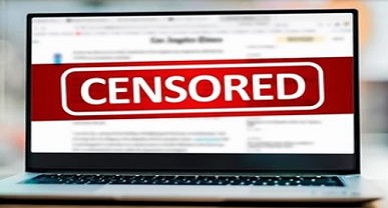Unveiling the Veil: Evolution of Censorship in Indian Cinema and the Quest for Artistic Freedom
INTRODUCTION
The word ‘Censorship’ is derived from the Latin word ‘cernere’ which means “to estimate, rate, assess, to be of option”[1]. Nevertheless, this definition is inaccurate and lacks clarity regarding its fundamental value. The “assessment” is carried out following careful analysis of the rights and wrongs, do or do not, and the exclusion or restriction is carried out in light of these. Although this restriction is sometimes applied on an individual basis and other times on a societal one, the traditional form of censorship is the most well-known when it comes to formal censorship. Whenever we attempt to define different types of censorship, however, we create ambiguity because the underlying organic structure is different. As a result, various definitions have been offered depending on how they understand it.
The history of Censorship is way back from the British Raj, where motion pictures in India began with an exhibition of the Lumiere Cinematograph in 1896 in Bombay[2]. Both in urban and rural regions, entertainment is becoming more and more popular. Prior to 1918, the idea of censorship existed in the Indian film industry. There was no substantive law present at that point of time therefore the random localities act as an ad hoc watch committee and function upon matter related to criminal law[3] which deals upon prohibition of publication of obscene matters[4] or matter which would hurt the religious sentiment or against the integrity of country. After several legislative modifications, the Cinematograph Act 1948 was established, and with time, the act was also developed and brought necessary changes with respect to the composition of boards and an age classification system for film censorship in India.

Nations approach the idea of censorship in different ways. While some countries believe regulations are vital, others believe it should be based on civil rights and human rights. Freedoms which evaluates or suppresses any content that abuses this privilege and has an impact on the country and society. But the alternative, more widely acknowledged version of events is that the government interfered with the regulating body only for its own interests rather than the interests of the people. This calls into serious doubt the independence and transparency of the CBFC. In a dozen of cases, the court has made decisions and attempted to clarify what constitutes a reasonable exercise of the restrictions specified under S. 19(2) of Indian Constitution. These restrictions are used in the larger interest of society to ensure that common people of any community are not disrespected by the exhibition that is objected by the society, to preserve a public decorum and avoid the unwanted thing which comes out from the “normalization,” by means of entertainment[5]. It has been well-evident and accepted principles throughout history and across jurisdictions that censorship has been frequently used to suppress any counter opinions- be it political or religious.
CINEMA AND CENSORSHIP:
The Indian government has occasionally prohibited films on the grounds that they would jeopardise communal and religious harmony, endangering the peace and harmony of the state. The justification listed in Article 19(2) is similar to the prohibition under Section 5B of the Cinematograph Act, 1952, which discusses the guidelines for Film Certification and the Cinematograph (Certification) Rules, 1983. The national and state governments are likewise granted this authority in their respective list of VII schedule. Government recommendations or notices are used to enforce these restrictions[6]. The paternal notion that the Indian viewer is immature is one of the most frequently used justifications for censoring movies in India[7]. The Delhi High Court challenged this presumption by ruling that a movie is a work of fiction, seeing a movie is a conscious decision made by the viewer, and anyone offended by the substance or topic of the movie is allowed to omit seeing it[8].
The constitution mechanism mentioned under Article 19(2) perform like a barricade[9]. Even in the case of Mahesh Bhatt v. Union of India[10], it was held that the right of filmmaker and the artist to use their representation method to exhibit life in all its solution, and struck down the rules which are mentioned under the cigarettes and other tobacco products Act, 2003. The interesting fact in relation to matters of social evil such as rape, prostitution, etc., which are depicted in any movies that cannot be censored[11]. The only thing that matter is that the scene must have any relevance to the theme of the movie.
CBFC: THE REGULATORY AUTHORITY IN INDIA
The British left India with censorship regulations. They used to take a rather authoritarian stance. Due to their severe rigidity and the undefined powers, they granted the Government, these laws used to draw strong objections from Indian artists[12]. The Indian government created an inquiry committee on film certification in response to these protests and worries. The Committee is required to scrutinize and suggest changes to India`s legal framework governing film censorship. The Cinematograph Act, 1952, which created the Central Board of Film Censorship[13]. Later, after the amendment was brought the body name was revised, and the results was it is now known as the Central Board of Film Certification (CBFC). The Film Certification Appellate Tribunal (FCAT), which serves as a dispute settlement mechanism between filmmakers and CBFC[14].
The Cinematograph (Certification) Rules, 1983 provide the procedure for certification procedure[15]. The Certification process is started by the Examining committee, the examination Committee (EC), whose members are chosen by the Regional Officer[16] (head of the CBFC Regional Office). When a film is lengthy, the EC needs a quorum of four members, two of whom must be Advisory Panel members (the usual feature films). Previously, A movie may be graded “A” for adults only, “U/A” for minors under 12, “S.” (limited to a specific audience), or “U” for unrestricted watching. But after the approval of Cinematograph (Amendment) Bill, 2023; “U/A” rating has been split into “U/A 7+”,”U/A 13+” and “U/A 16+”. The IT Rules, 2021 had implemented these graded age ratings fir streaming platforms[17].
If someone is unhappy with the EC`s judgement, they can appeal it to the reviewing committee (RC)[18]. The appeal will be reviewed by the five member RC, but if the judgement is not to everyone`s satisfaction, it will got to the FCAT[19] for a remedy. If that fails, the matter will ultimately come before the court.
Our court has made many rulings, published a number of guidelines, and placed restrictions on a number of issues in order to limit the CBFC`s authority. In this instance Bobby Art International v. Om Pal Singh Hoon[20], involves a rape scene in the film Bandit Queen, is a Landmark case about the interpretation of decency and morality. The court underlined the importance of the guidelines that the Central Government gave the CBFC in order to accredit films, noting that those with this responsibility need to be aware of social developments and considerate of societal norms and values.
Furthermore, a film that has been certified by the censorship board cannot be banned because it offends certain fringe groups or criticises the government. However, because these ideas are mandated by law and must be followed, the question of whether the Government and the CBFC have upheld this clear command from the courts emerges.
A fascinating example of this is the movie, ‘Kissa Kursi Ka’, which was published during the worst of the emergency period for free speech and expression. Since the film shows malpractice, corruption, and other like topics, the censor refuses to give it a certificate. After the change of government then, only the film was released[21]. This demonstrates that the government stopped people from exercising their fundamental rights. This context can be relatable in today`s time where the interference of government in the decision making of the board. It is evident that every person has a right to criticise the government and express it in the form of a movie.
JUDICIAL PRONOUNCEMENTS ON FILM CERTIFICATION AND CENSORSHIP
In the case of K.A Abbas v. Union of India[22] before the Hon`ble Supreme Court of India, various laws regarding Cinema certification and censorship were set under the Cinematograph Act in 1983, which was challenged as violating the Article 19(1)(a). The appellant arued that the CFBC`s refusal to grant his film a certificate without requiring several modifications, as well as several other Act sections, including Section 5(1)(b) abd Section 4, explicitly violate the basic right of freedom of speech and expression. The Supreme Court backed movie theatre censorship in this ruling, reasoning that movies should be viewed differently from other forms of art and expression since movies have the potential to evoke stronger feelings than any other kind of art. A movie may therefore be prohibited for the purposes listed in Article 19(2) of the Indian Constitution.
However, in the case of S. Rangarajan v. P. Jagjivan Ram[23], The Madras High Court had revoked the U certificate for the movie “Ore Oru Gramathille” on the grounds that it dealt with critical aspects of government reservation policy and might incite public unrest and lead to a breakdown of law and order in the state of Tamil Nadu. However, the Supreme Court overturned this decision, upholding the right to freedom of expression. The Supreme Court ruled in an appeal of the case that “it is the State`s duty to preserve freedom of expression because it is a liberty secured against the State.” The State cannot assert that it cannot handle the problem of hostile audiences.
In the case of Life Insurance Corporation of India v. Prof. Manubhai D. Shah[24], A national award-winning documentary on the “Bhopal Gas Tragedy” was chosen to air on Doordarshan, but the network declined, citing the fact that numerous political parties have raised concerns about documentary and that the tragedy`s victim compensation case is still pending. “Merely because it criticises the State Government is not a reason to refuse the film`s selection and publication; similarly, the topic is not sub-judicd by the pending compensation claims, thereby excluding the entire film from the community,” the Supreme Court said. In this instance, the court also stated that a citizen has the freedom to publish, circulate, and communicate his or her opinions in order to shape public opinion on critical issues of national importance, and that any attempt to restrict this liberty would be violation of Article 19(1)(a).
Section 6(1) of the Cinematograph Act,1952, was enacted by the government or executive after it witnessed excessive judicial intervention in efforts to defend freedom of speech and expression. This provision gave the board the authority to reverse an appellate tribunal`s [FCAT] ruling regarding film exhibition or regulation, but The Supreme Court ruled in the landmark case of Union of India v. K.M Shankarappa[25] that the legislation in question was unconstitutional and violated the Basic Structure Doctrine. The court also noted that the executive branch is required to comply with all court orders, that the government may request review, but it is not permitted to review or amend judicial orders, and that a tribunal consisting of a retired High Court Judge and established by statute to perform quasi-judicial functions has binding authority over the executive branch.
SUGGESTIONS
When it comes to the movie`s censorship, there has been a lot of politicisation. We now need to adapt to the times in order to restore the freedom of artistic expression. The most important ruling, which is still in effect, is K.A. Abbas v. Union of India[26]; it was handed down fifty years ago. However, the precedent that has been formed must be altered because movie regulations cover far more ground than just internet distribution. Furthermore, although films are subject to pre-censorship, online platforms are governed by post-censorship regulations.
Another significant aspect of the current legislation that needs modification is the requirements for becoming an advisory member. The central government has the exclusive authority to nominate. The parameters under which the person`s assessment is to be conducted are not stated in the act[27]. When a movie that is associated with that location blatantly transgresses the natural justice principles, this discretionary power is used. Therefore, the advisory council needs to be amended.
CONCLUSION
Cinema is a vital medium for the presentation of ideas and uncensored thoughts and ought to be unrestricted in every way. There should be no limitations on the freedom to voice one`s opinions in society. However, at the same time, one cannot ignore the realities of the community in which these ideas are propagated. The community`s safety and tranquillity shouldn`t be jeopardised in the name of opinion expression. Considering the influence that films can have on society, care must be taken when screening the film to avoid causing any kind of unrest or endangering national security.
Author:- Kaushik Das, in case of any queries please contact/write back to us at support@ipandlegalfilings.com or IP & Legal Filing.
[1] David Tribe, Questions of Censorship 36 (George Allen & Unwin, California, 1973)..
[2] P. Shah, The Indian Film 20 (1950).
[3] Mr. Raj Bahadur, Minister of Information and Broadcasting, said in 1966 that the government would “continue a liberal censorship” in the area of licensing films for public exhibition in India. Journal of the Film Industry, Feb. 25, 1966, at 3, quoted in N. Hunnings, Film Censors and the Law 18(1967).
[4] I.P.C. 1860, Sec 298.
[5] Utchins v. The State of Western Australia {2006} WASCA 258 at para 4.
[6] Press Trust of India, ‘Ram Rahim Singh`s “messenger of God” Screening Banned in Punjab, Section 144 Imposed in Sirse after Protest’ (The Indian Express, 20 January 2015) < https://indianexpress.com/article/india/india-others/messenger-of-god-controversy-tension-in-pockets-of-sirsa-section-144-imposed-at-places/> accessed 4 May 2024.
[7] Bhatia S, ‘”Censorship in India is Based on the Paternalistic Idea That Citizens Are Not Mature”’ (The Wire, 2 January 2016) < https://thewire.in/film/censorship-in-india-is-based-on-the-paternalistic-idea-that-citizens-are-not-mature> accessed 4 May 2024.
[8] Ajay Gautam v. Union of India & Ors., (2015) 217 DLT 297.
[9] Romesh Thappar v. State of Madras, AIR 1950 SC 124.
[10] (2009) 156 DLT 725.
[11] K.A. Abbas v. Union of India, (1970) 2 SCC 780.
[12] Report of the Enquiry Committee on Film Censorship (1949), (Govt. of India).
[13] The Cinematograph Act, 1952.
[14] The Cinematograph Act, 1952, S. 5-D.
[15] Cinematograph (certification) Rules, 1983.
[16] Cinematograph (certification) Rules, 11983, R. 22.
[17] Bureau TH, ‘Rajya Sabha Passes Cinematograph Amendment Bill, 2023 Aimed at Curbing Film Piracy” (The Hindu, 28 July 2023) < https://www.thehindu.com/news/national/rajya-sabha-passes-cinematograph-amendment-bill-2023-aimed-at-curbing-film-piracy/article67127843.ece> accessed 5 May 2024.
[18] Cinematograph (certification) Rules, 1983.
[19] Cinematograph Act, 1952, S. 5-C.
[20] 1996 (4) SCC 1.
[21] Ramnath N, ‘The Story behind the Controversial Film “Kissa Kursi Ka”, Which Was Banned during the Emergency’ (Scroll.in, 15 March 2021) < https://scroll.in/article/702429/banned-during-the-emergency-controversial-kissaa-kursee-kaa-movie-to-make-a-return> accessed 5 May 2024.
[22] (1970) 2 SCC 780.
[23] (1989) 2 SCC 574, 593.
[24] 1993 AIR 171.
[25] 1990 SCC OnLine Kar 149.
[26] (1970) 2 SCC 780.
[27] Natarajan A, ‘Film Certification in India and the Curse of Pre-Censorship’ (Live Law, 2 June 2017) https://www.livelaw.in/film-certification-india-curse-pre-censorship/ accessed 5 May 2024.


